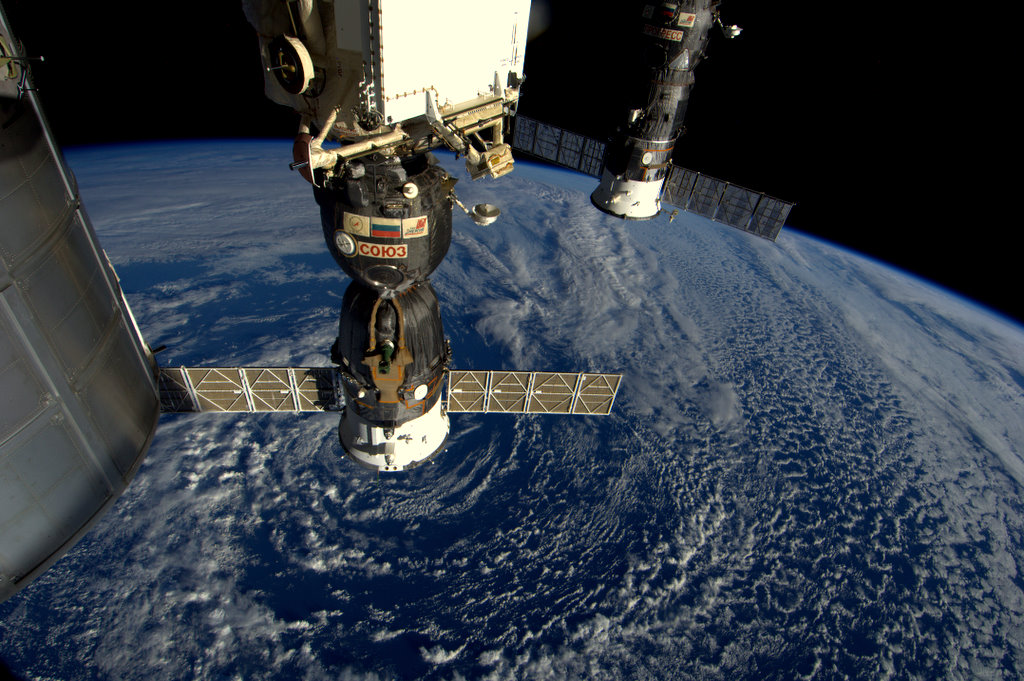NASA TV will be providing live coverage of the return to Earth of the Soyuz 29S spacecraft with astronauts Oleg Kononenko (Russia), Don Pettit (USA), and Andre Kuipers (ESA). Also aboard the vehicle will be the SSEP Aquarius payload of experiments that was launched on SpaceX Dragon on May 22, 2012. If you’ve been following this historic flight, you might want to tune in, and this post includes a live NASA TV video window. Below the video window is the official NASA Media Advisory which provides the schedule for coverage of farewell, hatch closure, undocking, de-orbit, and landing.
NASA MEDIA ADVISORY : M12-113
Coverage Set For Next Soyuz Space Station Crew Rotation
HOUSTON — Over the next several weeks, NASA Television will provide coverage of the departure of three crew members from the International Space Station and prelaunch, launch and arrival activities of three new residents.
Coverage will begin Wednesday, June 20, with the first of a series of Video Files of Expedition 32/33 Flight Engineers Suni Williams of NASA, Aki Hoshide of the Japan Aerospace Exploration Agency and Yuri Malenchenko of the Russian Federal Space Agency (Roscosmos) participating in training and ceremonial activities at the Gagarin Cosmonaut Training Center in Star City, Russia.
On June 29, NASA TV will broadcast a change of command ceremony aboard the orbiting laboratory in which Expedition 31 Commander Oleg Kononenko of Roscosmos will hand over the reins of command to Gennady Padalka. Padalka, a cosmonaut for Roscosmos, will become the International Space Station’s first three-time commander. When the Soyuz TMA-03M undocks on June 30, Expedition 31 will transition to Expedition 32 under Padalka’s command.
Kononenko and Flight Engineers Don Pettit of NASA and Andre Kuipers of the European Space Agency will depart the station in their Soyuz TMA-03M spacecraft June 30 for a July 1 landing in Kazakhstan to complete their six-and-a-half-month mission. Two weeks later, July 14 (July 15 in Kazakhstan), Williams, Hoshide and Malenchenko will launch to the station in the Soyuz TMA-05M spacecraft from the Baikonur Cosmodrome in Kazakhstan. The three will arrive at the station July 16 to join Padalka and Flight Engineers Joe Acaba of NASA and Sergei Revin of Roscosmos, who have been aboard the station since mid-May.
NASA TV’s scheduled coverage includes (all times Central):
Wednesday, June 20
11 a.m. — Video File of the Expedition 32/33 (Suni Williams, Yuri Malenchenko, Aki Hoshide) qualification training simulation runs at Star City, Russia.
Saturday, June 30
8:15 p.m. — Expedition 31 farewells and hatch closure coverage (hatch closure at 8:40 p.m.)
11:30 p.m. — Expedition 31/Soyuz TMA-03M undocking coverage (undocking at 11:53 p.m.)
Sunday, July 1
2 a.m. — Expedition 31/Soyuz TMA-03M deorbit burn and landing coverage (deorbit burn at 2:19 a.m., landing at 3:15 a.m.)
Saturday, July 14
8:30 p.m. — Expedition 32/33 Soyuz TMA-05M launch coverage (includes video b-roll of the crew’s prelaunch activities at 8:45 p.m.; launch scheduled at 9:40 p.m.)
Monday, July 16
11:15 p.m. — Expedition 32/33 Soyuz TMA-05M docking coverage (docking at 11:50 p.m. followed by post-docking news conference from Mission Control in Korolev, Russia)
Tuesday, July 17
2:15 a.m. — Expedition 32/33 Soyuz TMA-05M hatch opening and welcoming ceremony coverage (hatch opening and welcoming ceremony at 2:45 a.m.)
Additional Video File footage of the Expedition 32/33 crew’s pre-launch activities in Star City, Russia; Moscow; and Baikonur, Kazakhstan will be broadcast on NASA TV on June 22 and July 2, 10, 11, 12 and 13. Post-launch and post-docking Video Files will air on NASA TV on July 14 and 17. Video Files involving the Expedition 31 crew activities following their Soyuz landing in Kazakhstan will air on July 1.
For NASA’s complete list of Soyuz landing and launch coverage, visit:
For NASA TV downlink and streaming video information, visit:
For more information about the International Space Station and its crews, visit:
– end –
SSEP is undertaken by the National Center for Earth and Space Science Education (NCESSE) in partnership with NanoRacks LLC. This on-orbit research opportunity is enabled through NanoRacks LLC, which is working in partnership with NASA under a Space Act Agreement as part of the utilization of the International Space Station as a National Laboratory.
SSEP is the first pre-college STEM (Science, Technology, Engineering, and Math) education program that is both a U.S. national initiative and implemented as an on-orbit commercial space venture.


Comments are closed.